A joint report from JPMorgan and Fujitsu Australia predicts that housing credit growth will remain subdued for an extended period:
The three-month annualised growth rate [of housing credit] dropped from nine per cent in September 2010 to 6.7 per cent in February 2011 and is unlikely to return to double-digit growth rates seen before the global financial crisis (GFC).
“The outlook is not inspiring,” JPMorgan bank analyst Scott Manning told reporters after unveiling the mortgage industry report with Fujitsu’s industry group director Martin North.
Because housing credit growth is a function of house prices, new housing starts and borrowers’ loan to valuation (LVR) ratios, any housing growth rate above four per cent will be entirely due to rising house prices and/or a higher LVR on new lending, Mr Manning said.
Both Mr Manning and Mr North think system housing credit growth will likely remain between the mid to high single digits in coming years, with growth potentially crimped by banks’ having limited funding for housing credit.
As the cost of term funding in wholesale markets increased after the GFC, banks have been forced to refinance their outstanding bonds at higher prices.
This has resulted in an increased proportion of funds from annual bond issuance being consumed by refinancing, rather than being available to fund more credit growth, Mr Manning said…
As well, Commonwealth Bank and Westpac Banking Corporation had substantially pulled back on funding household deposit growth – a move Mr Manning said they could not afford over the long term given the importance of deposits to banks’ funding bases.
Meanwhile, household debt levels remain at historical highs, with about 10 per cent of disposable incomes being used to service mortgage interest payments assuming a standard variable borrowing rate of 7.8 per cent, Mr Manning said.
“If mortgage rates increase by 50 basis points by the end of 2011, then the proportion of disposable income servicing interest payments will return to historical highs about 11 per cent.”
Regardless of whether you believe that housing credit growth is a function of house prices (as JPMorgan and Fujitsu do) or house prices are a function of credit growth (as I do), the fact remains that credit is the main fuel that enables house prices to grow. And with housing credit growth predicted to remain subdued into the foreseeable future, there is little prospect of robust house price gains.
The correlation between mortgage credit growth and house prices is captured nicely in the below chart from Professor Steve Keen:
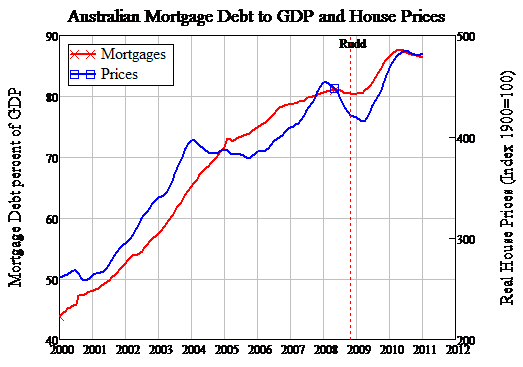
Much of this increased housing credit has been funded by:
- an increased emphasis by banks on mortgage lending relative to other forms of lending (e.g. lending to businesses); and
- heavy offshore borrowing by Australia’s lenders, led by the big four banks.
The first point is illustrated brilliantly by the below chart from deflationite.com, showing how in 1990, Australia’s banks lent around two-thirds to businesses and one-third to households. However, over the past 20 years, the banks have increasingly focussed their lending on housing such that business loans now account for only around one-third of total bank lending.
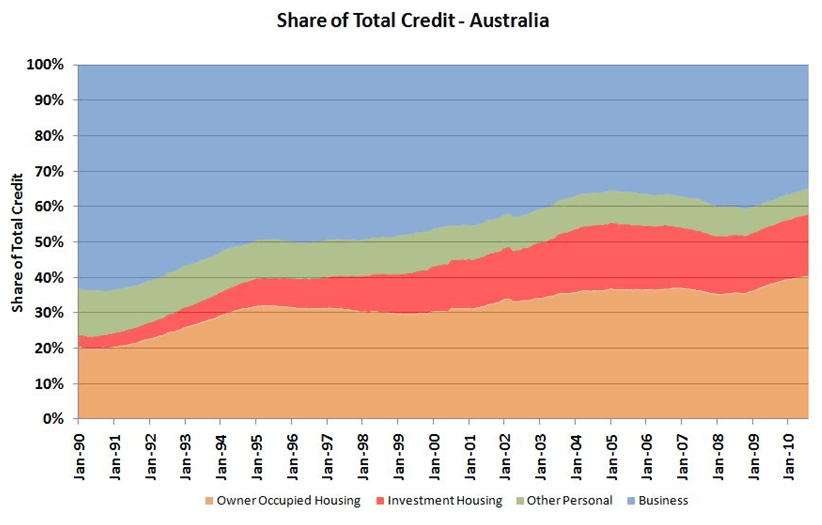
On the second point, the increasing reliance on offshore funding by Australia’s lenders is illustrated clearly by the below chart, showing a sharp increase in external liabilities by Depository Corporations over the past 20 years [note: the chart includes offshore borrowings by Australia’s banks (the lion’s share) as well as building societies, credit unions and registered financial corporations].
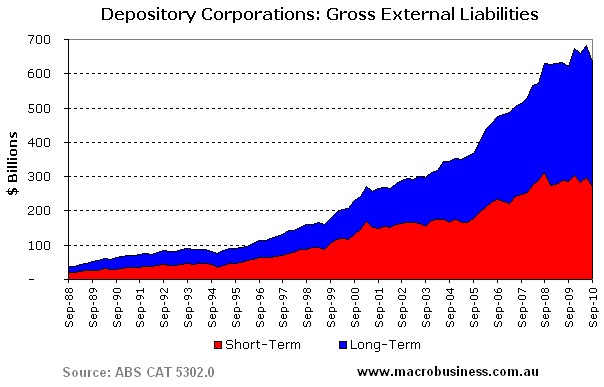
Focusing on Australia’s banks only, the below chart shows the massive growth of offshore borrowings, from around 5% of liabilities in January 1989 ($12 billion) to around 20% currently ($480 billion).
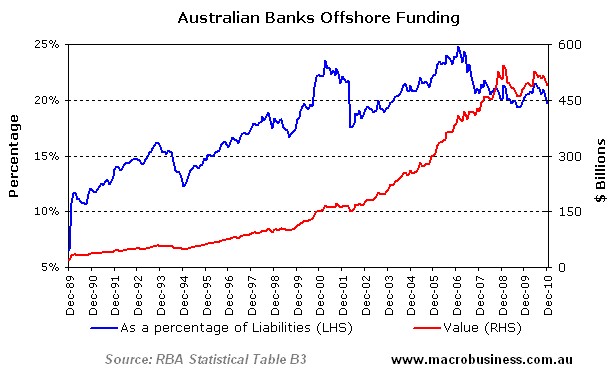
Finally, consider the below chart from fellow MacroBusiness blogger, Deep T., showing three indexes starting at January 2000 representing the growth in residential loan assets, bank deposits and offshore borrowings. It also includes a ratio to compare residential housing loans and deposits.
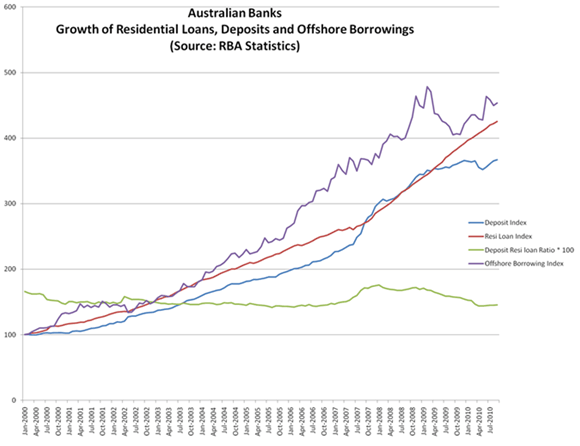
The purpose of the above charts is to show that the growth in Australian housing values has been funded, to a large degree, by foreign borrowings, mostly from the wholesale capital markets. However, as highlighted by JPMorgan and Fujitsu Australia, the cost of wholesale funding is rising. Moreover, earlier reports suggest that the banks will be loath to raise additional offshore funds as this could put their prized AA credit ratings at risk.
To add insult to injury, the banks are having difficulty replacing their wholesale funding with another low cost source, such as deposits, which means that their ability to support further house price growth appears to be limited. And without continued increases in debt issuance, there is little prospect of continued growth of housing values.
A prolonged period of price stagnation, therefore, remains the best case outcome for the Australian housing market.

